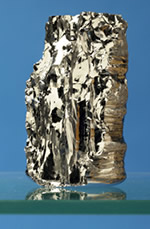 Tungsten, (or Wolfram as it is known in many parts of the world) is an extremely hard and very dense gray to white metallic element extracted from wolframite, scheelite and other minerals. Tungsten has the highest melting point, lowest coefficient of expansion and lowest vapor pressure of any metal. It is also corrosion resistant and does not break down or decompose. Due to its unique attributes tungsten has few, if any, replacements in a majority of its industrial applications.
Tungsten, (or Wolfram as it is known in many parts of the world) is an extremely hard and very dense gray to white metallic element extracted from wolframite, scheelite and other minerals. Tungsten has the highest melting point, lowest coefficient of expansion and lowest vapor pressure of any metal. It is also corrosion resistant and does not break down or decompose. Due to its unique attributes tungsten has few, if any, replacements in a majority of its industrial applications.
HARDNESS
- Second only to diamond (tungsten carbide)
- Industrial applications - high speed cutting tools, heavy machinery, specialty alloys
HEAT RESISTANCE
- Highest melting point and lowest coefficient of expansion of all metals
- Industrial applications - jet turbine engines, light bulb filaments
DENSITY
- Greater than lead and uranium
- Industrial applications - sporting goods (golf clubs, tennis racquets, darts), ballast
ENVIRONMENTALLY BENIGN
- Does not break down or decompose
- Industrial applications - sports fishing weights, shotgun shot, new applications being developed as an alternative to lead
For more information, please visit our Blog >>
A chemical element, W, atomic number 74, and atomic weight 183.85. Naturally occurring tungsten consists of five stable isotopes having the following mass numbers and relative abundances: 180 (0.14%), 182 (26.4%), 183 (14.4%), 184 (30.6%), and 186 (28.4%). Twelve radioactive isotopes ranging from 173 to 189 also have been characterized. See also Periodic table.
Tungsten crystallizes in a body-centered cubic structure in which the shortest interatomic distance is 274.1 picometers at 25°C (77°F). The pure metal has a lustrous, silver-white appearance. It possesses the highest melting point, lowest vapor pressure, and the highest tensile strength at elevated temperature of all metals. Some important physical properties of tungsten are compiled in the table.
At room temperature tungsten is chemically resistant to water, oxygen, most acids, and aqueous alkaline solutions, but it is attacked by fluorine or a mixture of concentrated nitric and hydrofluoric acids.
Physical properties of Tungsten
| Property |
Value |
Melting point |
3410 ± 20°C (6170 ± 36°F) |
Boiling point |
5700 ± 200°C (10,300 ± 360°F) |
Density, 27°C (81°F) |
19.3 g/cm3 (11.2 oz/in.3) |
Specific heat, 25°C (77°F) |
0.032 cal/g-°C (0.13 J/g-°C) |
Heat of fusion |
52.2 ± 8.7 cal/g (218 ± 36 J/g) |
Vapor pressure, 2027°C (3681°F) |
6.4 × 10−12 atm (6.5 × 10−7 Pa) |
3382°C (6120°F) |
2.3 × 10−5 atm (2.3 Pa) |
5470°C (9878°F) |
0.53 atm (5.4 × 104 Pa) |
Electrical resistivity, 27°C (81°F) |
5.65 microhm-cm |
1027°C (1881°F) |
34.1 |
3027°C (5481°F) |
103.3 |
Thermal conductivity, 27°C (81°F) |
0.43 cal/cm-s-°C (1.8 J/cm-s-°C) |
1027°C (1881°F) |
0.27 (1.1) |
Absorption cross section, |
18.5 ± 0.5 barns |
0.025-eV neutrons |
(18.5 ± 0.5 × 10−24 cm2) |
Tungsten is used widely as a constituent in the alloys of other metals, since it generally enhances high-temperature strength. Several types of tool steels and some stainless steels contain tungsten. Heat-resistant alloys, also termed superalloys, are nickel-, cobalt-, or iron-based systems containing varying amounts (typically 1.5–25 wt %) of tungsten. Wear-resistant alloys having the trade name Stellites are composed mainly of cobalt, chromium, and tungsten. See also Alloy; High-temperature materials.
The major use of tungsten in the United States is in the production of cutting and wear-resistant materials. Tungsten carbides (representing 60% of total tungsten consumption) are used for cutting tools, mining and drilling tools, dies, bearings, and armor-piercing projectiles.
Unalloyed tungsten (25% of tungsten consumption) in the form of wire is used as filaments in incandescent and fluorescent lamps, and as heating elements for furnaces and heaters. Because of its high electron emissivity, thorium-doped (thoriated) tungsten wire is employed for direct cathode electronic filaments. Tungsten rods find use as lamp filament supports, electrical contacts, and electrodes for arc lamps.
Tungsten compounds (5% of tungsten consumption) have a number of industrial applications. Calcium and magnesium tungstates are used as phosphors in fluorescent lights and television tubes. Sodium tungstate is employed in the fireproofing of fabrics and in the preparation of tungsten-containing dyes and pigments used in paints and printing inks. Compounds such as WO3 and WS2 are catalysts for various chemical processes in the petroleum industry. Both WS2 and WSe2 are dry, high-temperature lubricants. Other applications of tungsten compounds have been made in the glass, ceramics, and tanning industries.
Miscellaneous uses of tungsten account for the remainder (2%) of the metal consumed.

